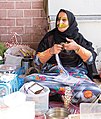Battoulah

 |
| Part of a series on |
| Islamic female dress |
|---|
| Types |
| Practice and law by country |
| Concepts |
| Other |
Battoulah (Arabic: البطولة, romanized: al-baṭṭūlah), also called Gulf Burqa (Arabic: البرقع الخليجي),[1][note 1] is a metallic-looking fashion mask traditionally worn by Muslim[5][6] Arab, Baluch, and Persian women. The mask is mainly worn in the Persian gulf region, including Bahrain, Kuwait, United Arab Emirates, Oman and Qatar, as well as in southern Iran.[7] Wearing the mask usually indicated that the person is married.[1] The mask was also used as a ruse to fool enemies into thinking that the women they spied from a distance were men.[8]
Origin[]
The origin of the battoulah is unknown,[7] Multiple theories exist on where it have originated. It is thought to have entered the Eastern Arabian Peninsula from Gujarat in late 18th century.[9]
Variants[]
Various variants of the Battoulah exist, including between cities and regions. In Dubai and Abu Dhabi, the "Zabeel cut" design, which has a narrow top and broad with a curved bottom is worn. In Sharjah it resembles the Zabeel cut but is shaped so the top of the mask is inclined forwards. The Al Ain design features both a narrow top and bottom. The Bahraini and Qatari burqa is square. In Oman and Fujairah it is very large and broader at the top with a tip that goes beyond the forehead. In neighbouring Saudi Arabia, the niqab is worn instead.[1] In southern provinces of Iran, Shia women wear red rectangular masks, while those of Sunni women are black or indigo with gold, similar to the mask worn in the Arabian peninsula.[8] In Qeshm, the masks were designed to fool invaders, so they would mistake women for male soldiers.[4]
Gallery[]

A woman wearing the Battoulah

An elderly female wearing the Battoulah in the United Arab Emirates

A woman wearing the Battoulah in Bandar Abbas fish market
See also[]
Notes[]
References[]
- ^ Jump up to: a b c "History Project: The burqa". The National. 1 December 2014.
- ^ "The story behind the mask". thezay.org. Retrieved 8 September 2021.
- ^ "In pictures: Iran and the masks of the Minab market". The Middle East Eye. 7 February 2019.
- ^ Jump up to: a b "The beautiful Iranian women captured in their boregheh masks". News Nation TV. 11 February 2019.
- ^ Brydon, Lynne; Chant, Sylvia H. (11 August 1989). Women in the Third World: Gender Issues in Rural and Urban Areas. Rutgers University Press. p. 29 – via Internet Archive.
batula islamic.
- ^ Qazi, Moin (11 August 2018). Women In Islam- Exploring New Paradigms. Notion Press. ISBN 9789384878030 – via Google Books.
- ^ Jump up to: a b electricpulp.com. "CLOTHING xxiii. Clothing of the Persian Gulf – Encyclopaedia Iranica". www.iranicaonline.org.
- ^ Jump up to: a b "The masked women of southern Iran". Qanatara.de. Retrieved 8 September 2021.
- ^ Rajab, Jehan S. (1997). Silver Jewellery of Oman. Kuwait: Tareq Rajab Museum; Palgrave Macmillan, pp. 48. & 52., ISBN 9781860643101
| Wikimedia Commons has media related to Battula. |
- Clothing stubs
- Arab culture
- Arabic clothing
- Islamic female clothing


